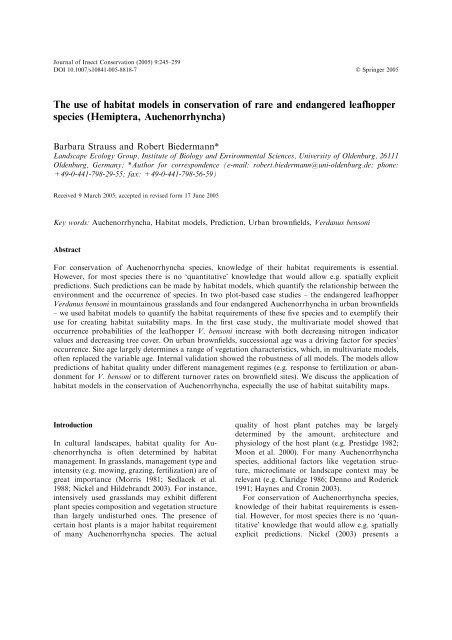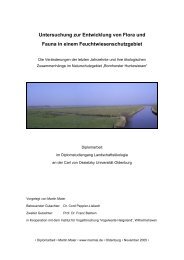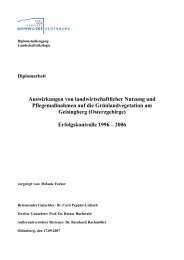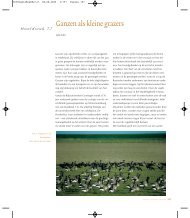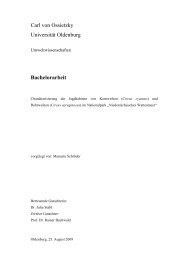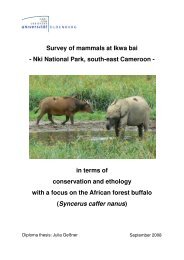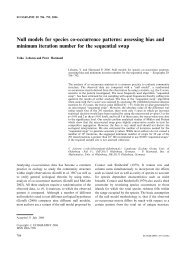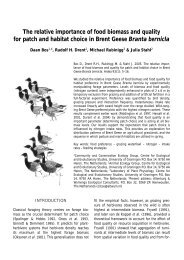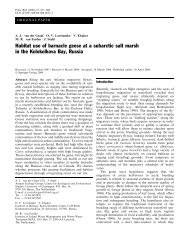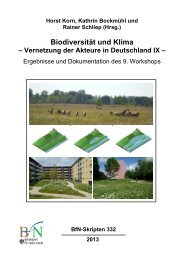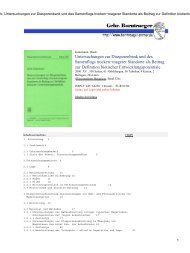The use of habitat models in conservation of rare and endangered ...
The use of habitat models in conservation of rare and endangered ...
The use of habitat models in conservation of rare and endangered ...
Create successful ePaper yourself
Turn your PDF publications into a flip-book with our unique Google optimized e-Paper software.
Journal <strong>of</strong> Insect Conservation (2005) 9:245–259<br />
DOI 10.1007/s10841-005-8818-7 Ó Spr<strong>in</strong>ger 2005<br />
-1<br />
<strong>The</strong> <strong>use</strong> <strong>of</strong> <strong>habitat</strong> <strong>models</strong> <strong>in</strong> <strong>conservation</strong> <strong>of</strong> <strong>rare</strong> <strong>and</strong> <strong>endangered</strong> leafhopper<br />
species (Hemiptera, Auchenorrhyncha)<br />
Barbara Strauss <strong>and</strong> Robert Biedermann*<br />
L<strong>and</strong>scape Ecology Group, Institute <strong>of</strong> Biology <strong>and</strong> Environmental Sciences, University <strong>of</strong> Oldenburg, 26111<br />
Oldenburg, Germany; *Author for correspondence (e-mail: robert.biedermann@uni-oldenburg.de; phone:<br />
+49-0-441-798-29-55; fax: +49-0-441-798-56-59)<br />
Received 9 March 2005; accepted <strong>in</strong> revised form 17 June 2005<br />
Key words: Auchenorrhyncha, Habitat <strong>models</strong>, Prediction, Urban brownfields, Verdanus bensoni<br />
Abstract<br />
For <strong>conservation</strong> <strong>of</strong> Auchenorrhyncha species, knowledge <strong>of</strong> their <strong>habitat</strong> requirements is essential.<br />
However, for most species there is no ‘quantitative’ knowledge that would allow e.g. spatially explicit<br />
predictions. Such predictions can be made by <strong>habitat</strong> <strong>models</strong>, which quantify the relationship between the<br />
environment <strong>and</strong> the occurrence <strong>of</strong> species. In two plot-based case studies – the <strong>endangered</strong> leafhopper<br />
Verdanus bensoni <strong>in</strong> mounta<strong>in</strong>ous grassl<strong>and</strong>s <strong>and</strong> four <strong>endangered</strong> Auchenorrhyncha <strong>in</strong> urban brownfields<br />
– we <strong>use</strong>d <strong>habitat</strong> <strong>models</strong> to quantify the <strong>habitat</strong> requirements <strong>of</strong> these five species <strong>and</strong> to exemplify their<br />
<strong>use</strong> for creat<strong>in</strong>g <strong>habitat</strong> suitability maps. In the first case study, the multivariate model showed that<br />
occurrence probabilities <strong>of</strong> the leafhopper V. bensoni <strong>in</strong>crease with both decreas<strong>in</strong>g nitrogen <strong>in</strong>dicator<br />
values <strong>and</strong> decreas<strong>in</strong>g tree cover. On urban brownfields, successional age was a driv<strong>in</strong>g factor for species’<br />
occurrence. Site age largely determ<strong>in</strong>es a range <strong>of</strong> vegetation characteristics, which, <strong>in</strong> multivariate <strong>models</strong>,<br />
<strong>of</strong>ten replaced the variable age. Internal validation showed the robustness <strong>of</strong> all <strong>models</strong>. <strong>The</strong> <strong>models</strong> allow<br />
predictions <strong>of</strong> <strong>habitat</strong> quality under different management regimes (e.g. response to fertilization or ab<strong>and</strong>onment<br />
for V. bensoni or to different turnover rates on brownfield sites). We discuss the application <strong>of</strong><br />
<strong>habitat</strong> <strong>models</strong> <strong>in</strong> the <strong>conservation</strong> <strong>of</strong> Auchenorrhyncha, especially the <strong>use</strong> <strong>of</strong> <strong>habitat</strong> suitability maps.<br />
Introduction<br />
In cultural l<strong>and</strong>scapes, <strong>habitat</strong> quality for Auchenorrhyncha<br />
is <strong>of</strong>ten determ<strong>in</strong>ed by <strong>habitat</strong><br />
management. In grassl<strong>and</strong>s, management type <strong>and</strong><br />
<strong>in</strong>tensity (e.g. mow<strong>in</strong>g, graz<strong>in</strong>g, fertilization) are <strong>of</strong><br />
great importance (Morris 1981; Sedlacek et al.<br />
1988; Nickel <strong>and</strong> Hildebr<strong>and</strong>t 2003). For <strong>in</strong>stance,<br />
<strong>in</strong>tensively <strong>use</strong>d grassl<strong>and</strong>s may exhibit different<br />
plant species composition <strong>and</strong> vegetation structure<br />
than largely undisturbed ones. <strong>The</strong> presence <strong>of</strong><br />
certa<strong>in</strong> host plants is a major <strong>habitat</strong> requirement<br />
<strong>of</strong> many Auchenorrhyncha species. <strong>The</strong> actual<br />
quality <strong>of</strong> host plant patches may be largely<br />
determ<strong>in</strong>ed by the amount, architecture <strong>and</strong><br />
physiology <strong>of</strong> the host plant (e.g. Prestidge 1982;<br />
Moon et al. 2000). For many Auchenorrhyncha<br />
species, additional factors like vegetation structure,<br />
microclimate or l<strong>and</strong>scape context may be<br />
relevant (e.g. Claridge 1986; Denno <strong>and</strong> Roderick<br />
1991; Haynes <strong>and</strong> Cron<strong>in</strong> 2003).<br />
For <strong>conservation</strong> <strong>of</strong> Auchenorrhyncha species,<br />
knowledge <strong>of</strong> their <strong>habitat</strong> requirements is essential.<br />
However, for most species there is no ‘quantitative’<br />
knowledge that would allow e.g. spatially<br />
explicit predictions. Nickel (2003) presents a
246<br />
comprehensive review <strong>of</strong> <strong>habitat</strong> requirements <strong>and</strong><br />
host plants <strong>of</strong> Auchenorrhyncha species <strong>in</strong><br />
Germany. However, the <strong>in</strong>formation is qualitative<br />
<strong>and</strong> descriptive rather than quantified. For<br />
<strong>in</strong>stance, Neophilaenus m<strong>in</strong>or is described as preferr<strong>in</strong>g<br />
‘sparse cover <strong>of</strong> vegetation’. S<strong>in</strong>ce exact<br />
figures are not provided it rema<strong>in</strong>s unclear whether<br />
the optimum is at 20% vegetation cover, or if 50%<br />
is still tolerated. For this reason, data-based predictions<br />
<strong>of</strong> <strong>habitat</strong> suitability, especially at the<br />
l<strong>and</strong>scape level, are not feasible.<br />
Such predictions can be made with <strong>habitat</strong><br />
<strong>models</strong>. <strong>The</strong> aims <strong>of</strong> <strong>habitat</strong> <strong>models</strong> are tw<strong>of</strong>old<br />
(e.g. Guisan <strong>and</strong> Zimmermann 2000; Scott et al.<br />
2002). First, <strong>habitat</strong> <strong>models</strong> analyze <strong>and</strong> quantify<br />
the relationship between species’ abundance or<br />
occurrence <strong>and</strong> <strong>habitat</strong> factors. Second, they<br />
yield predictions <strong>of</strong> species’ abundance or<br />
occurrence given certa<strong>in</strong> environmental conditions.<br />
<strong>The</strong> latter makes <strong>habitat</strong> <strong>models</strong> a potentially<br />
powerful tool <strong>in</strong> nature <strong>conservation</strong>:<br />
<strong>models</strong> are able to predict the probability <strong>of</strong><br />
occurrence for sites or l<strong>and</strong>scapes where species<br />
distribution data are not available (Wilson et al.<br />
2005). <strong>The</strong>y can also be <strong>use</strong>d to assess the effects<br />
<strong>of</strong> l<strong>and</strong> <strong>use</strong> changes or succession on <strong>habitat</strong><br />
quality (Rudner et al. 2005). Habitat suitability<br />
maps which can be obta<strong>in</strong>ed from <strong>habitat</strong> <strong>models</strong><br />
identify potential core <strong>habitat</strong>s <strong>of</strong> species <strong>and</strong><br />
form the basis for the plann<strong>in</strong>g <strong>of</strong> nature reserves<br />
(e.g. Cabeza et al. 2004). Such predictions <strong>of</strong><br />
spatial distribution are essential, s<strong>in</strong>ce <strong>conservation</strong><br />
plann<strong>in</strong>g has to deal with the whole l<strong>and</strong>scape<br />
(Wilson et al. 2005).<br />
Here, we <strong>use</strong> presence–absence data <strong>of</strong> Auchenorrhyncha<br />
species <strong>and</strong> environmental data to<br />
build <strong>habitat</strong> <strong>models</strong> based on logistic regression.<br />
In two case studies – the <strong>rare</strong> leafhopper Verdanus<br />
bensoni <strong>in</strong> mounta<strong>in</strong>ous grassl<strong>and</strong>s <strong>and</strong> four<br />
<strong>endangered</strong> Auchenorrhyncha <strong>in</strong> urban brownfields<br />
– we (1) demonstrate the procedure <strong>of</strong> model<br />
build<strong>in</strong>g, <strong>in</strong>clud<strong>in</strong>g variable selection, classification<br />
<strong>and</strong> <strong>in</strong>ternal validation, (2) quantify <strong>habitat</strong><br />
requirements <strong>of</strong> selected species, (3) exemplify the<br />
construction <strong>of</strong> <strong>habitat</strong> suitability maps, <strong>and</strong> (4)<br />
discuss the application <strong>of</strong> <strong>habitat</strong> <strong>models</strong> <strong>in</strong> the<br />
<strong>conservation</strong> <strong>of</strong> Auchenorrhyncha, especially <strong>rare</strong><br />
<strong>and</strong> <strong>endangered</strong> species. Rare here is understood<br />
as locally restricted due to <strong>rare</strong> <strong>habitat</strong>; the species<br />
can well build up considerable densities <strong>in</strong> their<br />
<strong>habitat</strong>s.<br />
Methods<br />
Study sites<br />
Case study 1: Leafhopper Verdanus bensoni<br />
<strong>The</strong> first case study <strong>in</strong>vestigated <strong>habitat</strong> requirements<br />
<strong>of</strong> the leafhopper Verdanus bensoni (Ch<strong>in</strong>a,<br />
1933). It was conducted <strong>in</strong> the mounta<strong>in</strong> ranges <strong>of</strong><br />
Dreisessel (1332 m; 48°47¢ N, 13°48¢ E) <strong>and</strong> Arber<br />
(1456 m; 49°06¢ N, 13°08¢ E) <strong>in</strong> the Bavarian<br />
Forest, Germany. <strong>The</strong> climate is characterized by<br />
mean annual temperatures between 5 <strong>and</strong> 6 °C<br />
with annual precipitation between 900 (low altitudes)<br />
<strong>and</strong> 2000 mm (high altitudes). For details<br />
on climate, geology <strong>and</strong> soil types see H<strong>of</strong>mann<br />
(1984). <strong>The</strong> area is largely covered by forests.<br />
While at altitudes up to approx. 1200 m, mixed<br />
forests (ma<strong>in</strong>ly beech, fir <strong>and</strong> spruce) are predom<strong>in</strong>ant,<br />
above this altitude only spruce forests<br />
are found. In the valleys <strong>and</strong> at lower altitudes<br />
l<strong>and</strong> <strong>use</strong> is characterized by a mix <strong>of</strong> forests, pastures<br />
<strong>and</strong> fields. At higher altitudes only few patches<br />
<strong>of</strong> grassl<strong>and</strong> are scattered with<strong>in</strong> the forests,<br />
ma<strong>in</strong>ly small pastures (‘Schachten’, see H<strong>of</strong>mann<br />
1984) <strong>and</strong> ski runs.<br />
Verdanus bensoni has a scattered range <strong>and</strong> is<br />
restricted to European mounta<strong>in</strong> ranges (Nickel<br />
2003). Up to now, it has been recorded from the<br />
German Alps, Scottish Highl<strong>and</strong>s, Swiss <strong>and</strong><br />
French Jura, Bavarian <strong>and</strong> Bohemian Forest,<br />
Giant Mounta<strong>in</strong>s, <strong>and</strong> Ural Mounta<strong>in</strong>s. In<br />
Germany, Verdanus bensoni is a <strong>rare</strong> species <strong>in</strong> the<br />
Alps <strong>and</strong> the Bavarian Forest. It is listed <strong>in</strong> the<br />
Red Data Book (Remane et al. 1998). In the study<br />
area, the Bavarian Forest, V. bensoni was recorded<br />
above approx. 800 m a.s.l. (Biedermann unpubl.).<br />
V. bensoni was found <strong>in</strong> montane <strong>and</strong> alp<strong>in</strong>e<br />
grassl<strong>and</strong>s, probably feed<strong>in</strong>g on grasses<br />
(Biedermann 1998; Nickel 2003). However, the<br />
specific <strong>habitat</strong> requirements have not been studied<br />
yet <strong>in</strong> detail.<br />
Case study 2: Endangered species <strong>in</strong> urban<br />
brown-fields<br />
<strong>The</strong> second case study was carried out on<br />
brownfield sites <strong>in</strong> the city <strong>of</strong> Bremen, located <strong>in</strong><br />
the lowl<strong>and</strong>s <strong>of</strong> northwest Germany (8°44¢ N,<br />
53°05¢ E, mean temperature 8.8 °C, mean annual<br />
precipitation 694 mm). Urban brownfields, previously-developed<br />
l<strong>and</strong> with<strong>in</strong> cities, <strong>of</strong>ten support a<br />
rich wildlife <strong>and</strong> ho<strong>use</strong> a whole range <strong>of</strong> <strong>rare</strong> <strong>and</strong>
247<br />
<strong>endangered</strong> species (Gibson 1998; Eyre et al.<br />
2003). <strong>The</strong>y can provide <strong>habitat</strong> for stenotopic<br />
species from semi-natural <strong>habitat</strong>s like dry s<strong>and</strong>y<br />
grassl<strong>and</strong>s (Eversham et al. 1996). Brownfields<br />
form highly dynamic <strong>habitat</strong>s (Gibson 1998;<br />
Gilbert 1989) which are cont<strong>in</strong>uously be<strong>in</strong>g generated,<br />
quickly changed by successional processes<br />
<strong>and</strong> destroyed by redevelopment. We assume that,<br />
with<strong>in</strong> this cycle, each species f<strong>in</strong>ds a limited period<br />
<strong>of</strong> time where its <strong>habitat</strong> requirements are met. In<br />
this study, we <strong>in</strong>vestigated four <strong>endangered</strong> species<br />
found on brownfield-sites: the leafhoppers<br />
Rhopalopyx vitripennis (Flor, 1861) <strong>and</strong> Macrosteles<br />
quadripunctulatus (Kirschbaum, 1868), the<br />
froghopper Neophilaenus m<strong>in</strong>or (Kirschbaum,<br />
1868) <strong>and</strong> the planthopper Kelisia sabulicola<br />
(W. Wagner, 1952). <strong>The</strong>y are listed as ‘threatened’<br />
or ‘potentially threatened’ (N. m<strong>in</strong>or) <strong>in</strong> Germany’s<br />
Red Data Book (Remane et al. 1998).<br />
Sampl<strong>in</strong>g design<br />
Case study 1<br />
For the Verdanus bensoni study, 42 plots (5 · 5m)<br />
were chosen at altitudes between 542 m <strong>and</strong><br />
1453 m a.s.l., depend<strong>in</strong>g on the availability <strong>of</strong><br />
grassl<strong>and</strong>s or forests with a grass layer. In each<br />
grassl<strong>and</strong> or forest the plots were chosen r<strong>and</strong>omly.<br />
In each plot the follow<strong>in</strong>g parameters were<br />
measured: total plant cover <strong>and</strong> cover <strong>of</strong> the predom<strong>in</strong>ant<br />
grass species <strong>in</strong> the herb layer, tree<br />
cover, slope, <strong>and</strong> altitude. Additionally, the mean<br />
Ellenberg <strong>in</strong>dicator values (Ellenberg et al. 1992)<br />
for moisture <strong>and</strong> nitrogen were calculated from the<br />
plant species composition. <strong>The</strong> occurrence <strong>of</strong><br />
Verdanus bensoni was recorded by sweep-nett<strong>in</strong>g.<br />
At each plot, 20 sweeps were taken cover<strong>in</strong>g the<br />
entire plot. <strong>The</strong> sweep-nett<strong>in</strong>g was repeated three<br />
times.<br />
Case study 2<br />
We <strong>in</strong>vestigated urban brownfields with<strong>in</strong> 77 km 2<br />
<strong>in</strong> the city <strong>of</strong> Bremen. On the brownfield sites, 157<br />
sample plots <strong>of</strong> 225 m 2 were set up <strong>in</strong> a r<strong>and</strong>om<br />
stratified way (Guisan <strong>and</strong> Zimmermann 2000;<br />
Hirzel <strong>and</strong> Guisan 2002; Magg<strong>in</strong>i et al. 2002).<br />
M<strong>in</strong>imum distance between plots was set to 80 m.<br />
To ensure that all characteristic types <strong>of</strong> brownfields<br />
got sampled, the plots covered three gradients:<br />
site size, age <strong>of</strong> brownfields (duration <strong>of</strong><br />
ab<strong>and</strong>onment) <strong>and</strong> soil moisture. In 2003, sweepnet<br />
sampl<strong>in</strong>g was carried out four times between<br />
early June <strong>and</strong> early September, with 100 sweeps<br />
each time.<br />
At each study plot we collected a set <strong>of</strong> environmental<br />
parameters. <strong>The</strong>se <strong>in</strong>cluded several<br />
parameters describ<strong>in</strong>g vegetation structure, cover<br />
<strong>of</strong> host plants (as specified by Nickel 2003), soil<br />
parameters <strong>and</strong> l<strong>and</strong>scape context. Site age, as<br />
time s<strong>in</strong>ce demolition <strong>of</strong> build<strong>in</strong>gs or any other<br />
severe disturbance that put succession back to<br />
zero, we derived from a time series <strong>of</strong> aerial photographs.<br />
L<strong>and</strong>scape context was assessed us<strong>in</strong>g a<br />
map <strong>of</strong> vegetation types. For examples <strong>of</strong> these<br />
vegetation types see Table 3. With<strong>in</strong> a GIS, we<br />
calculated the proportion <strong>of</strong> each <strong>of</strong> these types<br />
with<strong>in</strong> a certa<strong>in</strong> distance around every plot (Strauß<br />
et al. 2004). We tested radii between 25 <strong>and</strong> 125 m.<br />
For detailed measurement <strong>of</strong> vertical vegetation<br />
structure, we <strong>use</strong>d a white screen, divided <strong>in</strong> rectangles,<br />
that was erected perpendicular to the<br />
ground (see Sundermeier 1999). At six po<strong>in</strong>ts per<br />
plot, vertical cover was estimated for each rectangle<br />
look<strong>in</strong>g through a 10 cm wide st<strong>and</strong> <strong>of</strong><br />
vegetation. From these estimates, height <strong>and</strong><br />
density parameters were calculated (Table 3)<br />
(Sundermeier 1999; Zehm et al. 2003). 50%-height<br />
refers to the height below which 50% <strong>of</strong> the total<br />
vegetation cover is located. 75%-height <strong>and</strong> 90%-<br />
height are def<strong>in</strong>ed respectively.<br />
Statistical methods <strong>of</strong> <strong>habitat</strong> model<strong>in</strong>g<br />
Logistic regression<br />
We <strong>use</strong>d species’ presence/absence data for model<br />
build<strong>in</strong>g. A popular approach for model<strong>in</strong>g such<br />
data is us<strong>in</strong>g logistic regression (i.e. generalized<br />
l<strong>in</strong>ear <strong>models</strong> (GLM) with a logistic l<strong>in</strong>k)<br />
(Morrison et al. 1998; Guisan <strong>and</strong> Zimmermann<br />
2000; Hosmer <strong>and</strong> Lemeshow 2000; Harrell 2001;<br />
Re<strong>in</strong>ek<strong>in</strong>g <strong>and</strong> Schro¨ der 2003). Logistic regression<br />
has been successfully <strong>use</strong>d <strong>in</strong> numerous studies on<br />
<strong>habitat</strong>-occurrence relationships (e.g. Peeters <strong>and</strong><br />
Gardeniers 1998; Guisan et al. 1999; Manel et al.<br />
1999a). Metric variables can be h<strong>and</strong>led along with<br />
nom<strong>in</strong>al ones. <strong>The</strong> shape <strong>of</strong> the response curve can<br />
be either sigmoid or unimodal (‘bell-shaped’), the<br />
latter by <strong>in</strong>clud<strong>in</strong>g second order terms (Peeters <strong>and</strong><br />
Gardeniers 1998; Hosmer <strong>and</strong> Lemeshow 2000).<br />
<strong>The</strong> outcome <strong>of</strong> a logistic regression model is the
248<br />
occurrence probability at given parameter values.<br />
To dist<strong>in</strong>guish between predicted presence <strong>and</strong><br />
absence, a threshold probability needs to be def<strong>in</strong>ed.<br />
Predictions should stay restricted to the<br />
range <strong>of</strong> parameter values that has been covered<br />
by the study.<br />
Measures <strong>of</strong> model performance<br />
Numerous measures assess<strong>in</strong>g performance <strong>of</strong><br />
logistic regression <strong>models</strong> are available (Hosmer<br />
<strong>and</strong> Lemeshow 2000; Pearce <strong>and</strong> Ferrier 2000a;<br />
Manel et al. 2001). All <strong>of</strong> them can only describe<br />
certa<strong>in</strong> aspects <strong>of</strong> model performance. <strong>The</strong>refore,<br />
we <strong>use</strong>d a set <strong>of</strong> criteria, threshold-<strong>in</strong>dependent as<br />
well as threshold-dependent (Manel et al. 1999b).<br />
<strong>The</strong> difference between predicted <strong>and</strong> observed<br />
values (model calibration) was measured by R 2 N<br />
(Nagelkerke 1991). Like R 2 <strong>in</strong> l<strong>in</strong>ear regression, it<br />
ranges from 0 to 1. On an univariate level, we <strong>use</strong>d<br />
R 2 N to compare the relative <strong>in</strong>fluence that s<strong>in</strong>gle<br />
predictor variables had on species’ presence.<br />
Model discrim<strong>in</strong>ation was assessed with AUC<br />
(Hanley <strong>and</strong> McNeil 1982), the Area Under the<br />
receiver operat<strong>in</strong>g characteristic Curve (AUC).<br />
AUC values ‡0.7 are regarded as acceptable, ‡0.8<br />
as excellent, <strong>and</strong> ‡0.9 as outst<strong>and</strong><strong>in</strong>g (Hosmer <strong>and</strong><br />
Lemeshow 2000).<br />
Sensitivity (proportion <strong>of</strong> correctly predicted<br />
presences), specificity (proportion <strong>of</strong> correctly<br />
predicted absences) <strong>and</strong> CCR (correct classification<br />
rate) are classification threshold dependent<br />
measures. CCR is easy to <strong>in</strong>terpret, however largely<br />
dependent on the rather arbitrary choice <strong>of</strong> a<br />
threshold (Re<strong>in</strong>ek<strong>in</strong>g <strong>and</strong> Schro¨ der 2003) <strong>and</strong><br />
should be h<strong>and</strong>led with care. As a threshold, we<br />
chose P fair , where specificity <strong>and</strong> sensitivity are<br />
equivalent (Hosmer <strong>and</strong> Lemeshow 2000). S<strong>in</strong>ce<br />
the species under study are <strong>rare</strong> <strong>and</strong> their prevalence<br />
is low, P fair ensures that a reasonable proportion<br />
<strong>of</strong> presences will be predicted correctly. On<br />
the other h<strong>and</strong>, this may result <strong>in</strong> a lower total<br />
number <strong>of</strong> correct predictions (lower CCR) <strong>and</strong>, <strong>in</strong><br />
particular, more predicted presences for observed<br />
absences (lower specificity) than with other<br />
thresholds. For nature <strong>conservation</strong>, where <strong>of</strong>ten<br />
the aim will be to correctly predict as many relevant<br />
<strong>habitat</strong>s patches as possible (Morrison et al.<br />
1998), we believe that the advantages <strong>of</strong> P fair outrun<br />
these disadvantages.<br />
S<strong>in</strong>ce CCR, sensitivity <strong>and</strong> specificity are highly<br />
dependent on the species’ prevalence (Manel et al.<br />
2001), we <strong>use</strong>d Cohen’s Kappa j (Cohen 1960) as<br />
another, less sensitive threshold-dependent measure<br />
(Field<strong>in</strong>g <strong>and</strong> Bell 1997). Kappa ranges from<br />
0 to 1 with values between 0.40 <strong>and</strong> 0.55 <strong>in</strong>dicat<strong>in</strong>g<br />
fair agreement <strong>and</strong> values between 0.55 <strong>and</strong> 0.70<br />
<strong>in</strong>dicat<strong>in</strong>g good agreement between observed <strong>and</strong><br />
predicted values (Monserud <strong>and</strong> Leemans 1992).<br />
For comparison between <strong>models</strong> we <strong>use</strong>d the<br />
<strong>in</strong>formation criterion AIC c , a version <strong>of</strong> AIC<br />
(Akaike’s Information Criterion) modified for<br />
small samples (Buckl<strong>and</strong> et al. 1997). AIC <strong>in</strong>dicates<br />
how well a model performs the trade-<strong>of</strong>f<br />
between model fit <strong>and</strong> model complexity.<br />
Model build<strong>in</strong>g<br />
As recommended by Hosmer <strong>and</strong> Lemeshow<br />
(2000), we performed careful univariate analyses<br />
prior to build<strong>in</strong>g <strong>of</strong> multivariate <strong>models</strong>. For<br />
each species, we tested univariate <strong>models</strong> <strong>of</strong> all<br />
variables. Only significant variables (p £ 0.05)<br />
with R 2 N ‡ 0.05 were considered for further<br />
analysis.<br />
A popular approach for build<strong>in</strong>g multivariate<br />
<strong>models</strong> <strong>use</strong>s stepwise procedures for variable<br />
selection. Pearce <strong>and</strong> Ferrier (2000b) recommend<br />
the stepwise backward procedure, which we <strong>use</strong>d<br />
for the Verdanus bensoni study. In general, all<br />
stepwise procedures have some disadvantages<br />
(Re<strong>in</strong>ek<strong>in</strong>g <strong>and</strong> Schro¨ der 2004). <strong>The</strong>y might not<br />
f<strong>in</strong>d the best model, or selection is unstable <strong>and</strong><br />
does not hold for slightly different data. With a<br />
large number <strong>of</strong> predictor variables, like <strong>in</strong> the<br />
brownfield study, stepwise procedures perform<br />
poorly. <strong>The</strong>refore, <strong>in</strong> that study, we followed a<br />
different approach: we calculated <strong>models</strong> for all<br />
comb<strong>in</strong>ations <strong>of</strong> four, three <strong>and</strong> two parameters,<br />
us<strong>in</strong>g Splus 6.1 functions glm <strong>and</strong> stepAIC (MASS<br />
library). S<strong>in</strong>ce the ratio ‘number <strong>of</strong> observations’/<br />
‘predictor variables’ should not fall much below 10<br />
(Morrison et al. 1998; Guisan <strong>and</strong> Zimmermann<br />
2000), more than four variables per model are not<br />
a sound choice for the available data sets.<br />
Strong correlations between predictor variables<br />
will lead to abnormally high coefficients <strong>and</strong><br />
st<strong>and</strong>ard errors (Neter et al. 1989). <strong>The</strong>refore,<br />
maximum spearman rank correlation (r S ) between<br />
predictor variables with<strong>in</strong> one model was allowed<br />
to be 0.7 (Field<strong>in</strong>g <strong>and</strong> Haworth 1995). S<strong>in</strong>ce<br />
height <strong>and</strong> density parameters <strong>in</strong> the brownfield<br />
study showed strong correlations, only one <strong>of</strong> each<br />
group was chosen for multivariate model<strong>in</strong>g.
249<br />
Model validation<br />
Performance criteria are usually over-optimistic if<br />
they are calculated on the same data set that was<br />
<strong>use</strong>d for parameter estimation (Re<strong>in</strong>ek<strong>in</strong>g <strong>and</strong><br />
Schro¨ der 2003). S<strong>in</strong>ce <strong>in</strong>dependent data were not<br />
available to correct for this optimism, we <strong>use</strong>d the<br />
bootstrap as an <strong>in</strong>ternal validation method<br />
(Verbyla <strong>and</strong> Litaitis 1989; Efron <strong>and</strong> Tibshirani<br />
1993) for evaluat<strong>in</strong>g the <strong>models</strong>. Accord<strong>in</strong>g to<br />
Steyerberg et al. (2001) <strong>and</strong> Harrell (2001), it<br />
outperforms other <strong>in</strong>ternal validation procedures<br />
<strong>and</strong> allows nearly unbiased estimates <strong>of</strong> model<br />
performance. We performed the bootstrap with<br />
Splus 6.1, do<strong>in</strong>g 300 iterations, result<strong>in</strong>g <strong>in</strong> corrected<br />
measures <strong>of</strong> model performance.<br />
Habitat suitability maps<br />
Habitat suitability maps can be obta<strong>in</strong>ed by<br />
apply<strong>in</strong>g the regression equations <strong>of</strong> <strong>habitat</strong><br />
<strong>models</strong> to maps <strong>of</strong> the relevant environmental data<br />
with<strong>in</strong> a GIS. <strong>The</strong>se maps spatially explicitly predict<br />
the probability <strong>of</strong> occurrence <strong>of</strong> the focal<br />
species (Osborne et al. 2001; Aust<strong>in</strong> 2002; Joy <strong>and</strong><br />
Death 2004). Models <strong>use</strong>d for such spatially explicit<br />
predictions are restricted to parameters that<br />
are available area-wide. In the brownfield-study,<br />
these were age <strong>of</strong> brownfield sites, <strong>and</strong> all l<strong>and</strong>scape<br />
context parameters. For N. m<strong>in</strong>or, we calculated<br />
a model from these parameters <strong>and</strong><br />
applied it to part <strong>of</strong> the study area.<br />
Results<br />
Univariate <strong>models</strong><br />
Case study1<br />
<strong>The</strong> univariate logistic regression analysis revealed<br />
that a number <strong>of</strong> significant <strong>habitat</strong> parameters<br />
were related to the <strong>in</strong>cidence <strong>of</strong> Verdanus bensoni<br />
(Table 1). <strong>The</strong> occurrence <strong>of</strong> V. bensoni was positively<br />
related to altitude <strong>and</strong> moisture <strong>in</strong>dicator<br />
<strong>and</strong> negatively to nitrogen <strong>in</strong>dicator <strong>and</strong> tree cover.<br />
<strong>The</strong> <strong>habitat</strong> parameters slope <strong>and</strong> total plant cover<br />
showed no effect on the occurrence <strong>of</strong> V. bensoni.<br />
Likewise, the cover <strong>of</strong> s<strong>in</strong>gle grass species had no<br />
positive <strong>in</strong>fluence on the occurrence <strong>of</strong> V. bensoni.<br />
Case study 2<br />
For the brownfield study, univariate responses for<br />
all relevant variables are listed <strong>in</strong> Table 3. A total<br />
<strong>of</strong> 29 predictor variables passed the performance<br />
criteria. Age was a strong predictor for all four<br />
species. M. quadripunctulatus showed a sigmoid<br />
response, occurrence probability decreas<strong>in</strong>g with<br />
<strong>in</strong>creas<strong>in</strong>g age (Figure 2), whereas the other species<br />
showed unimodal responses with peaks<br />
between 13 <strong>and</strong> 20 years.<br />
Vegetation height did not play an important role<br />
for M. quadripunctulatus. K. sabulicola, N. m<strong>in</strong>or<br />
<strong>and</strong> R. vitripennis showed similar, mostly unimodal<br />
responses to vegetation height <strong>and</strong> density<br />
parameters. R. vitripennis made an exception <strong>in</strong><br />
preferr<strong>in</strong>g high density <strong>in</strong> the lowest layer. For<br />
M. quadripunctulatus, high overall density<br />
decreased occurrence probability, whereas it<br />
preferred moderate densities with<strong>in</strong> the lower<br />
vegetation layers.<br />
Most species exhibited strong relationships with<br />
moss cover, litter cover <strong>and</strong> bare ground. As with<br />
density <strong>and</strong> height, K. sabulicola was negatively<br />
correlated with moss <strong>and</strong> litter cover, whereas the<br />
other species preferred medium to high values for<br />
these parameters. In general, high covers <strong>of</strong> the<br />
respective host plants strongly enhanced occurrence<br />
probabilities. PH was the most important<br />
amongst the soil parameters. M. quadripunctulatus<br />
preferred high, whilst N. m<strong>in</strong>or <strong>and</strong> R. vitripennis<br />
preferred medium levels.<br />
Overall, the <strong>in</strong>fluence <strong>of</strong> l<strong>and</strong>scape context was<br />
comparatively weak with two exceptions. Occurrence<br />
<strong>of</strong> N. m<strong>in</strong>or <strong>in</strong>creased with ris<strong>in</strong>g proportions<br />
<strong>of</strong> brownfields with grassy, sparse vegetation.<br />
M. quadripunctulatus showed an unimodal response<br />
to the proportion <strong>of</strong> open brownfields with<br />
250<br />
Multivariate <strong>models</strong><br />
Case study 1<br />
<strong>The</strong> multivariate <strong>habitat</strong> model for V. bensoni<br />
conta<strong>in</strong>ed two significant <strong>habitat</strong> parameters (Table<br />
2). <strong>The</strong> model showed that with both<br />
decreas<strong>in</strong>g nitrogen <strong>in</strong>dicator values <strong>and</strong> decreas<strong>in</strong>g<br />
tree cover the <strong>in</strong>cidence <strong>of</strong> V. bensoni <strong>in</strong>creased<br />
(Figure 1). Model discrim<strong>in</strong>ation was good (Table<br />
2): <strong>in</strong> 85% <strong>of</strong> the plots occurrence <strong>of</strong> V. bensoni<br />
was correctly classified.<br />
Case study 2<br />
<strong>The</strong> f<strong>in</strong>al multivariate <strong>models</strong> for the brownfield<br />
species conta<strong>in</strong>ed three or four (N. m<strong>in</strong>or)<br />
explanatory variables (Table 3). Model performance<br />
measures are given <strong>in</strong> Table 5, coefficients,<br />
st<strong>and</strong>ard errors <strong>and</strong> p-values <strong>in</strong> Table 4.<br />
<strong>The</strong> model for R. vitripennis <strong>in</strong>cluded the<br />
parameters age, moss cover <strong>and</strong> cover <strong>of</strong> Festuca<br />
rubra/ov<strong>in</strong>a. Occurrence probabilities were highest<br />
at medium levels <strong>of</strong> age <strong>and</strong> moss cover (Figure 3).<br />
With <strong>in</strong>creas<strong>in</strong>g cover <strong>of</strong> Festuca, the <strong>in</strong>fluence <strong>of</strong><br />
these parameters became negligible; occurrence<br />
probabilities always exceeded the threshold.<br />
Occurrence <strong>of</strong> N. m<strong>in</strong>or could be expla<strong>in</strong>ed best<br />
with a four-parameter model. Occurrence probabilities<br />
above the threshold were restricted to low,<br />
but non-zero 50%-heights, regardless <strong>of</strong> the other<br />
parameter values (Figure 4). Moderate litter covers<br />
were preferred <strong>in</strong> comb<strong>in</strong>ation with low cover<br />
<strong>of</strong> Corynephorus canescens <strong>and</strong> low proportions <strong>of</strong><br />
Table 2. Case study 1: Multiple <strong>habitat</strong> model <strong>of</strong> the leafhopper<br />
Verdanus bensoni.<br />
Model parameters & coefficients<br />
Nitrogen <strong>in</strong>dicator 1.94218<br />
Tree cover 0.05667<br />
Intercept 7.33042<br />
Model performance<br />
Significance p < 0.001<br />
R 2 Ncorr 0.56<br />
AUC corr 0.88<br />
Classification P fair<br />
P fair 0.48<br />
j 0.72<br />
Sensitivity 0.88<br />
Specificity 0.85<br />
CCR 0.85<br />
Model parameters, model performance <strong>and</strong> classification us<strong>in</strong>g<br />
the threshold P fair .<br />
P<br />
1<br />
0<br />
1<br />
Nitrogen<br />
<strong>in</strong>dicator<br />
7<br />
100<br />
Tree<br />
cover [%]<br />
Figure 1. Multiple <strong>habitat</strong> model for Verdanus bensoni. Probability<br />
<strong>of</strong> occurrence (P) is plotted aga<strong>in</strong>st nitrogen <strong>in</strong>dicator<br />
<strong>and</strong> tree cover.<br />
P<br />
1<br />
Kelisia sabulicola<br />
Rhopalopyx vitripennis<br />
Neophilaenus m<strong>in</strong>or<br />
Macrosteles quadripunctulatus<br />
0<br />
0 10 20 30 40<br />
Age [years]<br />
Figure 2. Univariate response curves for the variable ‘age’.<br />
BGS75. With <strong>in</strong>creas<strong>in</strong>g values <strong>of</strong> either or both <strong>of</strong><br />
these parameters, the modify<strong>in</strong>g <strong>in</strong>fluence <strong>of</strong> litter<br />
cover decreased. M. quadripunctulatus reached<br />
high occurrence probabilities only at moderate to<br />
high pH-levels <strong>and</strong> <strong>in</strong> comb<strong>in</strong>ation with both little<br />
to no litter cover <strong>and</strong> medium proportions <strong>of</strong><br />
BO75 (Figure 6). <strong>The</strong> shape <strong>of</strong> the response surface<br />
<strong>of</strong> Kelisia sabulicola strongly depended on the<br />
cover <strong>of</strong> Carex arenaria. High values <strong>of</strong> 10% led to<br />
occurrence probabilities close to one, regardless <strong>of</strong><br />
the other two factors (Figure 5). At low cover <strong>of</strong><br />
Carex, presence depended on medium levels <strong>of</strong> age<br />
<strong>and</strong> vegetation density <strong>in</strong> the 0–5 cm layer. Model<br />
performance was better for R. vitripennis, N. m<strong>in</strong>or<br />
<strong>and</strong> M. quadripunctulatus (R 2 N > 0.41, AUC<br />
0
251<br />
Table 3. Case study 2: Univariate responses: R 2 N <strong>and</strong> shape <strong>of</strong> response curves. R 2 N <strong>of</strong> variables <strong>in</strong>cluded <strong>in</strong> best multiple <strong>models</strong><br />
pr<strong>in</strong>ted bold.<br />
Variable/Parameter Range M. quad. K. sabul. N. m<strong>in</strong>or R. vitrip.<br />
R 2 N R 2 N R 2 N R 2 N<br />
Age [years] 0–33 0.16 S 0.13 U 0.19 U 0.21 U<br />
Vegetation height [cm]<br />
Veg. height 0–110 0.22 U<br />
Weighted height 0–24 0.09 U 0.10 U 0.18 U<br />
Max. height 0–117 0.05 +S 0.20 U<br />
50%-height 0–10 0.14 U<br />
75%-height 0–28 0.11 U 0.08 U<br />
90%-height 0–63 0.06 U 0.13 U<br />
Vegetation density [%]<br />
Veg. cover (horizontal) 0–90 0.05 S 0.14 U 0.22 U<br />
Veg. density (vertical) 0–21 0.08 S 0.22 U<br />
Veg. dens. 0–5 cm 0–92 0.16 U 0.14 U 0.07 U 0.18 +S<br />
Veg. dens. 5–15 cm 0–66 0.14 U 0.13 U 0.07 U<br />
Veg. dens. 15–50 cm 0–28 0.06 S 0.13 U<br />
Veg. dens. 50–100 cm 0–20 0.07 U<br />
Density variation 0–7 0.11 U<br />
Other vegetation parameters [%]<br />
Moss cover 0–100 0.23 S 0.05 +S 0.05 +S 0.23 U<br />
Litter cover 0–100 0.27 S 0.08 U 0.18 +S<br />
Bare ground 0–100 0.20 U 0.12 S 0.06 S 0.18 S<br />
Cover <strong>of</strong> host plants [%]<br />
Festuca rubra/ov<strong>in</strong>a 0–88 0.05 +S 0.40 +S<br />
Carex arenaria 0–19 0.20 +S<br />
Corynephorus canescens 0–38 0.29 +S<br />
Soil<br />
Effective cation exchange capacity 2–15 0.09 U 0.07 U<br />
pH 3.4–7.7 0.24 +S 0.18 U 0.12 U<br />
Stone content (topsoil) 0–6 0.08 +S 0.07 U 0.17 S<br />
Available water capacity 4–193 0.08 +S 0.05 +S<br />
L<strong>and</strong>scape context: Proportion <strong>of</strong> brownfields, covered with a certa<strong>in</strong> structural vegetation type, with<strong>in</strong> a radius <strong>of</strong> 75 m [%]<br />
Open ( 0.84) than for K. sabulicola (R 2 N = 0.29, AUC<br />
= 0.77, Table 3).<br />
Habitat suitability map<br />
<strong>The</strong> <strong>habitat</strong> suitability map for N. m<strong>in</strong>or (Figure 8)<br />
was based on a two-parameter model with age <strong>and</strong><br />
BGS75. Occurrence probability steeply rose with<br />
<strong>in</strong>creas<strong>in</strong>g proportions <strong>of</strong> BGS75, <strong>in</strong> particular <strong>in</strong><br />
comb<strong>in</strong>ation with medium age (Figure 7). As the<br />
threshold was low (0.13), most <strong>of</strong> the response<br />
surface was above the threshold. Nevertheless,<br />
large proportions <strong>of</strong> the brownfield sites (62%)<br />
have low values for BGS75 comb<strong>in</strong>ed with young<br />
age, result<strong>in</strong>g <strong>in</strong> occurrence probabilities below the<br />
threshold, shown as white regions on the map. <strong>The</strong><br />
model yielded poorer performance than the best
252<br />
Table 4. Case study 2: Model performance <strong>of</strong> multiple <strong>models</strong>. All performance measures corrected by bootstrapp<strong>in</strong>g. (+^2) <strong>in</strong>dicates that the second order term is <strong>in</strong>cluded to<br />
model an univariate response.<br />
Threshold dependent: P fair<br />
Species pres./abs. Model parameters Threshold<br />
<strong>in</strong>dependent<br />
R 2 N AUC Pfair j Sensitivity Specificity CCR<br />
0.42 0.85 0.21 0.49 0.77 0.81 0.80<br />
Rhopalopyx vitripennis 33/124 Age (+^2) + Moss%(+^2) +<br />
Festuca.rubra/ov<strong>in</strong>a%<br />
0.50 0.90 0.15 0.43 0.75 0.81 0.80<br />
Neophilaenus m<strong>in</strong>or 25/132 50%-height (+^2) + Litter%(+^2) +<br />
Corynephorus.canescens% + BGS75<br />
Neophilaenus m<strong>in</strong>or 25/132 Age (+^2) + BGS75 0.38 0.83 0.13 0.36 0.73 0.78 0.77<br />
Macrosteles quadripunctulatus 58/99 Litter% + pH + BO75 (+^2) 0.41 0.84 0.41 0.52 0.76 0.78 0.77<br />
0.29 0.77 0.17 0.28 0.67 0.72 0.70<br />
Kelisia sabulicola 30/127 Age (+^2) + Veg.dens.0–5 cm (+^2) +<br />
Carex.arenaria%<br />
model for the species (Table 5), with R 2 N at 0.38<br />
<strong>and</strong> AUC at 0.83. Sensitivity <strong>and</strong> specificity were<br />
at 0.76 <strong>and</strong> 0.77, respectively. Out <strong>of</strong> the 28 plots<br />
with<strong>in</strong> the section shown <strong>in</strong> the map (Figure 8), all<br />
n<strong>in</strong>e presences were predicted correctly, six <strong>of</strong> the<br />
19 absences were classified <strong>in</strong>correctly as presences.<br />
Discussion<br />
Case study 1<br />
For V. bensoni, the most important <strong>habitat</strong> factor<br />
was found to be the fertility <strong>of</strong> the grassl<strong>and</strong> sites.<br />
V. bensoni was restricted to low productivity sites.<br />
Consequently, agricultural <strong>in</strong>tensification <strong>and</strong> fertilization<br />
<strong>of</strong> the low productivity <strong>habitat</strong>s would<br />
pose a threat to V. bensoni. Further, the occurrence<br />
<strong>of</strong> V. bensoni would decrease if the tree cover<br />
<strong>of</strong> grassl<strong>and</strong> sites <strong>in</strong>creased, for <strong>in</strong>stance, after<br />
ab<strong>and</strong>onment <strong>of</strong> mow<strong>in</strong>g or graz<strong>in</strong>g. <strong>The</strong>re was no<br />
relationship between the occurrence <strong>of</strong> V. bensoni<br />
<strong>and</strong> the cover <strong>of</strong> s<strong>in</strong>gle grass species. It was known<br />
from literature that V. bensoni lives on grasses <strong>and</strong><br />
it has been argued that V. bensoni may <strong>use</strong> several<br />
grass species as host plants (Biedermann 1998;<br />
Nickel 2003). Our results confirm that V. bensoni<br />
obviously is not a host plant specialist like, for<br />
<strong>in</strong>stance, Neophilaenus m<strong>in</strong>or.<br />
Case study 2<br />
With<strong>in</strong> our dataset, age <strong>of</strong> brownfield sites was the<br />
most driv<strong>in</strong>g factor determ<strong>in</strong><strong>in</strong>g species’ occurrence.<br />
This agrees with the results <strong>of</strong> Small et al.<br />
(2003) for carabid assemblages, who found that<br />
time s<strong>in</strong>ce the last disturbance has a significant<br />
<strong>in</strong>fluence on species’ occurrence. In the study by<br />
Brown et al. (1992), successional age had a strong<br />
effect on leafhopper assemblages. Characteristic<br />
stages <strong>of</strong> brownfield succession strongly depend on<br />
time (Gilbert 1989), but substrate can modify<br />
succession rates considerably (Gilbert 1989; Small<br />
et al. 2003). <strong>The</strong> ma<strong>in</strong> difference between successional<br />
stages lies <strong>in</strong> their vegetation structures<br />
(Hollier et al. 1994). This might be the reason why<br />
<strong>in</strong> two <strong>of</strong> the ‘best’ multivariate <strong>models</strong>, age was<br />
substituted by vegetation parameters. <strong>The</strong>y prob-
253<br />
Table 5. Case study 2: Coefficients <strong>and</strong> p-values <strong>of</strong> the multiple <strong>models</strong>.<br />
Coeff. S.E. p<br />
Macrosteles quadripunctulatus<br />
Intercept 5.09507 1.32829
254<br />
Cover <strong>of</strong> Festuca rubra / F. ov<strong>in</strong>a [%]<br />
0% 40% 70%<br />
1<br />
1<br />
1<br />
P<br />
P<br />
P<br />
0<br />
35<br />
100<br />
0<br />
35<br />
100<br />
0<br />
35<br />
100<br />
Age<br />
[years]<br />
0<br />
Moss<br />
Cover [%]<br />
Age<br />
[years]<br />
0<br />
Moss<br />
Cover [%]<br />
Age<br />
[years]<br />
0<br />
Moss<br />
Cover [%]<br />
Figure 3. Best <strong>habitat</strong> model for Rhopalopyx vitripennis. Occurrence probability (P) on the z-axis, aga<strong>in</strong>st age <strong>and</strong> moss cover. Three<br />
levels <strong>of</strong> Festuca rubra/ov<strong>in</strong>a-cover are represented <strong>in</strong> the three diagrams.<br />
Cover <strong>of</strong> Corynephorus canescens [%]<br />
Proportion <strong>of</strong> brownfields with grassy, sparse vegetation with<strong>in</strong> 75m [%]<br />
0%<br />
40%<br />
80%<br />
1<br />
P<br />
1<br />
P<br />
1<br />
P<br />
0<br />
12<br />
50%-<br />
Height [cm]<br />
0<br />
12<br />
50%-<br />
Height [cm]<br />
0<br />
12<br />
50%-<br />
Height [cm]<br />
0% 15% 30%<br />
Litter<br />
Cover [%]<br />
0<br />
1<br />
1<br />
P<br />
P<br />
0<br />
0<br />
100<br />
12<br />
100<br />
12<br />
50%-<br />
Litter<br />
50%-<br />
Height [cm]<br />
Cover [%]<br />
Height [cm]<br />
0<br />
0<br />
Litter<br />
50%-<br />
Cover [%]<br />
Height [cm]<br />
0<br />
1<br />
P<br />
0<br />
100<br />
12<br />
Litter<br />
50%-<br />
Cover [%]<br />
Height [cm]<br />
0<br />
1<br />
P<br />
0<br />
100<br />
12<br />
0<br />
0<br />
Litter<br />
50%-<br />
Cover [%]<br />
Height [cm]<br />
0<br />
1<br />
P<br />
0<br />
100<br />
12<br />
Litter<br />
50%-<br />
Cover [%]<br />
Height [cm]<br />
0<br />
1<br />
P<br />
0<br />
100<br />
12<br />
100<br />
Litter<br />
Cover [%]<br />
100<br />
Litter<br />
Cover [%]<br />
100<br />
Litter<br />
Cover [%]<br />
Figure 4. Best <strong>habitat</strong> model for Neophilaenus m<strong>in</strong>or. In each diagram, P is plotted aga<strong>in</strong>st 50%-Height <strong>and</strong> litter cover. Columns<br />
represent different levels <strong>of</strong> Corynephorus canescens-cover <strong>and</strong> rows represent different proportions <strong>of</strong> BGS75.<br />
context might be due to two factors. First, most<br />
Auchenorrhyncha species seem to not need large<br />
sites to build up viable populations (Biedermann<br />
2002, 2004; Cron<strong>in</strong> 2004). Second, it is likely that<br />
for Auchenorrhyncha, most brownfield sites are<br />
not truly isolated. Small patches <strong>of</strong> potential<br />
<strong>habitat</strong> are found along most roads <strong>and</strong> tracks <strong>and</strong><br />
connect the larger sites.<br />
Overall, univariate responses <strong>of</strong> all four species<br />
corresponded well to <strong>habitat</strong> requirements<br />
described <strong>in</strong> Nickel (2003). For <strong>in</strong>stance,<br />
M. quadripunctulatus is regarded as a pioneer<br />
species preferr<strong>in</strong>g s<strong>and</strong>y, sparsely vegetated <strong>and</strong><br />
moderately dry to dry sites. This agrees with our<br />
results that the species was restricted to young sites<br />
with very scarce vegetation.
255<br />
Cover <strong>of</strong> Carex arenaria [%]<br />
0% 3% 10%<br />
1<br />
1<br />
1<br />
P<br />
P<br />
P<br />
0<br />
35<br />
100<br />
0<br />
35<br />
100<br />
0<br />
35<br />
100<br />
Age<br />
[years]<br />
0<br />
Veg. Dens.<br />
0-5cm [%]<br />
Age<br />
[years]<br />
0<br />
Veg. Dens.<br />
0-5cm [%]<br />
Age<br />
[years]<br />
0<br />
Veg. Dens.<br />
0-5cm [%]<br />
Figure 5. Best <strong>habitat</strong> model for Kelisia sabulicola. P is plotted aga<strong>in</strong>st age <strong>and</strong> vegetation density 0–5 cm; diagrams represent different<br />
levels <strong>of</strong> Carex arenaria cover.<br />
pH<br />
pH 3.5 pH 5.5 pH 7.5<br />
1<br />
1<br />
1<br />
P<br />
P<br />
P<br />
0<br />
100<br />
100<br />
0<br />
100<br />
100<br />
0<br />
100<br />
100<br />
BO75 [%]<br />
0<br />
Litter<br />
Cover [%]<br />
BO75 [%]<br />
0<br />
Litter<br />
Cover [%]<br />
BO75 [%]<br />
0<br />
Litter<br />
Cover [%]<br />
Figure 6. Best <strong>habitat</strong> model for Macrosteles quadripunctulatus. P plotted aga<strong>in</strong>st BO75 <strong>and</strong> litter cover; diagrams represent different<br />
levels <strong>of</strong> pH.<br />
P<br />
1<br />
0<br />
35<br />
Age<br />
[years]<br />
0<br />
<strong>The</strong> <strong>use</strong> <strong>of</strong> <strong>habitat</strong> <strong>models</strong> <strong>in</strong> <strong>conservation</strong><br />
100<br />
BGS75 [%]<br />
Figure 7. Model <strong>use</strong>d to calculate a <strong>habitat</strong> suitability map for<br />
Neophilaenus m<strong>in</strong>or. P plotted aga<strong>in</strong>st age <strong>and</strong> BGS75.<br />
Internal validation showed the robustness <strong>of</strong><br />
<strong>habitat</strong> <strong>models</strong> with<strong>in</strong> our studies. However, <strong>in</strong><br />
perspective, it would be desirable to validate these<br />
<strong>models</strong> externally, i.e. apply them to <strong>in</strong>dependent<br />
data sets from other l<strong>and</strong>scapes. In this respect, it<br />
would be <strong>in</strong>terest<strong>in</strong>g to test whether the <strong>habitat</strong><br />
model <strong>of</strong> Verdanus bensoni from the Bavarian<br />
Forest is applicable to Alp<strong>in</strong>e populations. <strong>The</strong><br />
transfer <strong>of</strong> <strong>habitat</strong> <strong>models</strong> has been successfully<br />
demonstrated <strong>in</strong> other <strong>in</strong>sects (Kuhn <strong>and</strong> Kleyer<br />
1999/2000; Schro¨ der <strong>and</strong> Richter 1999/2000; Bonn<br />
<strong>and</strong> Schro¨ der 2001; B<strong>in</strong>zenho¨ fer et al. 2005).<br />
Unfortunately, up till now there have been no attempts<br />
with Auchenorrhyncha. However, transferability<br />
is regarded as a prerequisite for the<br />
broad application <strong>of</strong> <strong>habitat</strong> <strong>models</strong> <strong>in</strong> the <strong>conservation</strong><br />
<strong>of</strong> Auchenorrhyncha.<br />
<strong>The</strong> <strong>habitat</strong> <strong>models</strong> presented here are able to<br />
predict the quality <strong>of</strong> <strong>habitat</strong>s under different<br />
management. In the leafhopper Verdanus bensoni,<br />
the <strong>habitat</strong> model predicts the response to fertilization<br />
or ab<strong>and</strong>onment. In the urban brownfield<br />
study, the effects <strong>of</strong> different turnover rates became<br />
obvious. Models are able to predict the<br />
occurrence <strong>of</strong> species along a temporal gradient <strong>of</strong>
256<br />
Figure 8. Habitat suitability map for Neophilaenus m<strong>in</strong>or. Non-brownfield sites (sealed areas: e.g. roads, build<strong>in</strong>gs, conta<strong>in</strong>er parks;<br />
farml<strong>and</strong>: mostly wet grassl<strong>and</strong>) are considered per se as unsuitable <strong>habitat</strong>s (matrix) <strong>and</strong> dotted on the map.<br />
succession. This quantitative <strong>in</strong>formation may be<br />
essential for the <strong>conservation</strong> <strong>of</strong> species <strong>in</strong><br />
brownfields. It was shown that the species under<br />
study are restricted to the early or <strong>in</strong>termediate<br />
stages <strong>of</strong> brownfield succession. Once sites become<br />
too old, these species are likely to disappear. Small<br />
et al. (2003) found for carabid beetles that the<br />
most species rich assemblages are found on early<br />
successional sites that can be between 6 <strong>and</strong><br />
20 years old. For <strong>conservation</strong>, this implies that<br />
protection <strong>of</strong> exist<strong>in</strong>g brownfield-sites without<br />
management will ca<strong>use</strong> many species to disappear<br />
over time. In order to preserve high biodiversity,<br />
one should focus on the duration <strong>of</strong> the brownfield<br />
stage with<strong>in</strong> the cycle <strong>of</strong> emergence, succession <strong>and</strong><br />
demolition <strong>of</strong> brownfields sites. A constant stock<br />
<strong>of</strong> brownfields <strong>of</strong> young <strong>and</strong> <strong>in</strong>termediate age<br />
with<strong>in</strong> an <strong>in</strong>dustrial area preserves the typical<br />
species assemblage.<br />
<strong>The</strong> case studies also showed that <strong>in</strong> some<br />
species it is possible to build <strong>habitat</strong> <strong>models</strong> with<br />
good performance us<strong>in</strong>g only a few <strong>habitat</strong><br />
parameters. For <strong>in</strong>stance, <strong>in</strong> Verdanus bensoni<br />
two parameters were sufficient to reach a high<br />
correct classification rate. For <strong>conservation</strong> purpose,<br />
those <strong>habitat</strong> <strong>models</strong> may be a tool to<br />
identify potential <strong>habitat</strong> rely<strong>in</strong>g on only a small<br />
number <strong>of</strong> environmental parameters. Even<br />
though a large number <strong>of</strong> parameters might be<br />
necessary to detect the driv<strong>in</strong>g forces <strong>and</strong> build<br />
well perform<strong>in</strong>g <strong>models</strong>, once these parameters<br />
are known, <strong>models</strong> can easily be applied to other<br />
regions, assum<strong>in</strong>g the availability <strong>of</strong> data for the<br />
parameters. In the light <strong>of</strong> <strong>in</strong>creas<strong>in</strong>g availability<br />
<strong>of</strong> area-wide environmental data (e.g. from satellite<br />
imagery or public GIS databases) this<br />
prerequisite will be easier to meet <strong>in</strong> future.<br />
However, some variables, like the ones describ<strong>in</strong>g<br />
aspects <strong>of</strong> vegetation structure <strong>in</strong> a detailed<br />
way, can not be obta<strong>in</strong>ed area-wide by these<br />
methods. Still, these variables are <strong>of</strong> great<br />
importance when study<strong>in</strong>g a species’ ecological<br />
needs. Hence, for <strong>habitat</strong> suitability maps, these<br />
variables have to be substituted by ones that are<br />
available area-wide. <strong>The</strong> application <strong>of</strong> <strong>habitat</strong><br />
suitability maps <strong>in</strong> <strong>conservation</strong> may easily<br />
identify <strong>and</strong> map areas for protection (e.g.<br />
Cabeza et al. 2004). However, there are some issues<br />
to consider when apply<strong>in</strong>g <strong>habitat</strong> <strong>models</strong> <strong>and</strong><br />
<strong>habitat</strong> suitability maps. First, species’ absences<br />
can never be recorded with the same certa<strong>in</strong>ty as<br />
species’ presences. Kleyer et al. (1999/2000) suggest<br />
regard<strong>in</strong>g presence <strong>and</strong> absence as a species-specific<br />
characteristic. Second, false-positive predictions do<br />
not necessarily <strong>in</strong>dicate a poor model fit, s<strong>in</strong>ce plots<br />
recorded as non-<strong>use</strong> are not always unsuitable<br />
<strong>habitat</strong> (Capen et al. 1986). This is particularly<br />
true <strong>in</strong> decl<strong>in</strong><strong>in</strong>g populations, where many falsepositive<br />
predictions might result (Wilson et al.<br />
2005): due to an <strong>in</strong>creased ext<strong>in</strong>ction rate, suitable<br />
<strong>habitat</strong> might not be <strong>in</strong>habited. Thus, <strong>habitat</strong><br />
suitability maps may help to identify areas for the
257<br />
re<strong>in</strong>troduction <strong>of</strong> <strong>endangered</strong> or <strong>rare</strong> species by<br />
show<strong>in</strong>g potentially suitable <strong>habitat</strong>.<br />
In conclusion, this study demonstrated the<br />
build<strong>in</strong>g <strong>and</strong> application <strong>of</strong> <strong>habitat</strong> <strong>models</strong> for<br />
Auchenorrhyncha. Although further research is<br />
needed, especially on the generality <strong>of</strong> s<strong>in</strong>gle<br />
species <strong>habitat</strong> <strong>models</strong>, the value <strong>of</strong> <strong>habitat</strong><br />
<strong>models</strong> for <strong>conservation</strong> seems obvious. <strong>The</strong> <strong>use</strong> <strong>of</strong><br />
<strong>habitat</strong> suitability maps could f<strong>in</strong>d broad application<br />
<strong>in</strong> future.<br />
Acknowledgements<br />
<strong>The</strong> brownfield case study is part <strong>of</strong> the TEMPOproject<br />
<strong>and</strong> was f<strong>in</strong>ancially supported by the<br />
German M<strong>in</strong>istry <strong>of</strong> Education <strong>and</strong> Research<br />
(BMBF, grant 01LM0210). We thank Ute Schadek<br />
for provid<strong>in</strong>g soil data for the brownfield<br />
study. <strong>The</strong> manuscript was improved by helpful<br />
comments <strong>of</strong> two anonymous referees.<br />
References<br />
Aust<strong>in</strong> M.P. 2002. Spatial prediction <strong>of</strong> species distribution: an<br />
<strong>in</strong>terface between ecological theory <strong>and</strong> statistical modell<strong>in</strong>g.<br />
Ecol. Model. 157: 101–118.<br />
Achtziger R. 1995. Die Struktur von Insektengeme<strong>in</strong>schaften an<br />
Gehölzen: Die Hemipteren-Fauna als Beispiel fu¨ r die Biodiversität<br />
von Hecken und Waldr<strong>and</strong>o¨ kosystemen. Bayreuther<br />
Forum Ökologie (bfö) 20: 1–216.<br />
Biedermann R. 1997. Populationso¨ kologische Untersuchungen<br />
an Zikaden (Homoptera, Auchenorrhyncha): zum E<strong>in</strong>fluß<br />
von Habitatqualita¨ t, Habitatgro¨ ße und Isolation auf das<br />
Vorkommen und U¨ berleben von Populationen. University <strong>of</strong><br />
Ma<strong>in</strong>z, Ma<strong>in</strong>z, PhD thesis.<br />
Biedermann R. 1998. Erstnachweis der Zwergzikade Verdanus<br />
bensoni (Ch<strong>in</strong>a, 1933) (Homoptera, Auchenorrhyncha, Cicadellidae)<br />
fu¨ r Deutschl<strong>and</strong>. Entomolog. Nachr. Ber. 42: 83.<br />
Biedermann R. 2002. Leafhoppers (Hemiptera, Auchenorrhyncha)<br />
<strong>in</strong> fragmented <strong>habitat</strong>s. Denisia 4: 523–530.<br />
Biedermann R. 2004. Patch occupancy <strong>of</strong> two hemipterans<br />
shar<strong>in</strong>g a common host plant. J. Biogeogr. 31: 1179–1184.<br />
B<strong>in</strong>zenhöfer B., Schröder B., Strauss B., Biedermann R. <strong>and</strong><br />
Settele J. 2005. Habitat <strong>models</strong> <strong>and</strong> <strong>habitat</strong> connectivity<br />
analysis for butterflies <strong>and</strong> burnet moths – the example <strong>of</strong><br />
Zygaena carniolica <strong>and</strong> Coenonympha arcania. Biol. Conserv,<br />
In press.<br />
Brown V.K., Gibson C.W.D. <strong>and</strong> Kathirithamby J. 1992.<br />
Community organization <strong>in</strong> leaf hoppers. Oikos 65: 97–106.<br />
Bonn A. <strong>and</strong> Schro¨ der B. 2001. Habitat <strong>models</strong> <strong>and</strong> their<br />
transfer for s<strong>in</strong>gle- <strong>and</strong> multi species groups: a case study <strong>of</strong><br />
carabids <strong>in</strong> an alluvial forest. Ecography 24: 483–496.<br />
Buckl<strong>and</strong> S.T., Burnham K.P. <strong>and</strong> August<strong>in</strong> N.H. 1997. Model<br />
selection: an <strong>in</strong>tegral part <strong>of</strong> <strong>in</strong>ference. Biometrics 53: 603–618.<br />
Buckl<strong>and</strong> S.T. <strong>and</strong> Elston D.A. 1993. Empirical <strong>models</strong> for the<br />
spatial distribution <strong>of</strong> wildlife. J. Appl. Ecol. 30: 478–495.<br />
Cabeza M., Arau´ jo M.B., Wilson R.J., Thomas C.D., Cowley<br />
M.J.R. <strong>and</strong> Moilanen A. 2004. Comb<strong>in</strong><strong>in</strong>g probabilities <strong>of</strong><br />
occurrence with spatial reserve design. J. Appl. Ecol. 41: 252–<br />
262.<br />
Capen D.E., Fenwick J.W., Inkley D.B. <strong>and</strong> Boynton A.C.<br />
1986. Multivariate <strong>models</strong> <strong>of</strong> songbird <strong>habitat</strong> <strong>in</strong> New<br />
Engl<strong>and</strong> forests. In: Verner J., Morrison M.L. <strong>and</strong> Ralph C.J<br />
(eds), Wildlife 2000: Model<strong>in</strong>g Habitat Relationships <strong>of</strong><br />
Terrestrial Vertebrates. University <strong>of</strong> Wiscons<strong>in</strong> Press,<br />
Madison, pp. 171–177.<br />
Claridge D.W. 1986. <strong>The</strong> distribution <strong>of</strong> a typhlocyb<strong>in</strong>e leafhopper,<br />
Ribautiana ulmi (Homoptera, Cicadellidae) on a<br />
specimen wych elm tree. Ecol. Entomol. 11: 31–39.<br />
Cohen J. 1960. A coefficient <strong>of</strong> agreement for nom<strong>in</strong>al scales.<br />
Educat. Psychol. Measure 30: 37–46.<br />
Cron<strong>in</strong> J.T. 2004. Host-parasitoid ext<strong>in</strong>ction <strong>and</strong> colonization<br />
<strong>in</strong> a fragmented l<strong>and</strong>scape. Oecologia 139: 503–514.<br />
Denno R.F. 1994. Influence <strong>of</strong> <strong>habitat</strong> structure on the abundance<br />
<strong>and</strong> diversity <strong>of</strong> planthoppers. In: Denno R.F. <strong>and</strong><br />
Perfect T.J. (eds), Planthoppers – <strong>The</strong>ir Ecology <strong>and</strong> Management.<br />
Chapman & Hall, London, pp. 140–160.<br />
Denno R.F. <strong>and</strong> Roderick G.K. 1991. Influence <strong>of</strong> patch size,<br />
vegetation texture, <strong>and</strong> host plant architecture on the<br />
diversity, abundance, <strong>and</strong> life history styles <strong>of</strong> sap-feed<strong>in</strong>g<br />
herbivores. In: Bell S.S., McCoy E.D. <strong>and</strong> Mush<strong>in</strong>sky H.R.<br />
(eds.), Habitat structure: <strong>The</strong> Physical Arrangement <strong>of</strong><br />
Objects <strong>in</strong> Time <strong>and</strong> Space. Chapman <strong>and</strong> Hall, London,<br />
pp. 169–196.<br />
Efron B. <strong>and</strong> Tibshirani R.J. 1993. An Introduction to the<br />
Bootstrap. Chapman <strong>and</strong> Hall, New York.<br />
Ellenberg H., Weber H.E., Du¨ ll R., Wirth W., Werner W. <strong>and</strong><br />
Paulißen D. 1992. Zeigerwerte von Pflanzen <strong>in</strong> Mitteleuropa.<br />
Verlag Erich Goltze, Go¨ tt<strong>in</strong>gen.<br />
Eversham B.C., Roy D.B. <strong>and</strong> Telfer M.G. 1996. Urban,<br />
<strong>in</strong>dustrial <strong>and</strong> other manmade sites as analogues <strong>of</strong> natural<br />
<strong>habitat</strong>s for Carabidae. Ann. Zool. Fenn. 33: 149–156.<br />
Eyre M.D., Luff M.L. <strong>and</strong> Woodward J.C. 2003. Beetles<br />
(Coleoptera) on brownfield sites <strong>in</strong> Engl<strong>and</strong>: an important<br />
<strong>conservation</strong> resource? J. Insect Conserv. 7: 223–231.<br />
Field<strong>in</strong>g A.H. <strong>and</strong> Bell J.F. 1997. A review <strong>of</strong> methods for the<br />
assessment <strong>of</strong> prediction errors <strong>in</strong> <strong>conservation</strong> presence-absence<br />
<strong>models</strong>. Environ. Conserv. 24: 38–49.<br />
Field<strong>in</strong>g A.H. <strong>and</strong> Haworth P.F. 1995. Test<strong>in</strong>g the generality <strong>of</strong><br />
bird-<strong>habitat</strong> <strong>models</strong>. Conserv. Biol. 9: 1466–1481.<br />
Geiger R., Aron R.H. <strong>and</strong> Todhunter P. 2003. <strong>The</strong> Climate<br />
near the Ground. Rowman <strong>and</strong> Littlefield, Lanham.<br />
Gibson C.W.D. 1998. Brownfield: Red Data – <strong>The</strong> Values<br />
Artificial Habitats Have for Uncommon Invertebrates.<br />
English Nature Research Reports, 273<br />
Gilbert O.L. 1989. <strong>The</strong> Ecology <strong>of</strong> Urban Habitats. Chapman<br />
<strong>and</strong> Hall, London.<br />
Guisan A., Weiss S.B. <strong>and</strong> Weiss A.D. 1999. GLM versus CCA<br />
spatial model<strong>in</strong>g <strong>of</strong> plant species distribution. Plant Ecol.<br />
143: 107–122.<br />
Guisan A. <strong>and</strong> Zimmermann N.E. 2000. Predictive <strong>habitat</strong><br />
distribution <strong>models</strong> <strong>in</strong> ecology. Ecol. Model. 135: 147–186.<br />
Hanley J.A. <strong>and</strong> McNeil B.J. 1982. <strong>The</strong> mean<strong>in</strong>g <strong>and</strong> <strong>use</strong> <strong>of</strong> the<br />
area under a ROC curve. Radiology 143: 29–36.
258<br />
Harrell F.E. 2001. Regression Model<strong>in</strong>g Strategies. Spr<strong>in</strong>ger,<br />
New York.<br />
Haynes K.J. <strong>and</strong> Cron<strong>in</strong> J.T. 2003. Matrix composition affects<br />
the spatial ecology <strong>of</strong> a prairie planthopper. Ecology 84:<br />
2856–2866.<br />
Hirzel A. <strong>and</strong> Guisan A. 2002. Which is the optimal sampl<strong>in</strong>g<br />
strategy for <strong>habitat</strong> suitability model<strong>in</strong>g. Ecol. Model. 157:<br />
329–339.<br />
H<strong>of</strong>mann A. 1984. Magerrasen im H<strong>in</strong>teren Bayerischen Wald.<br />
Hoppea 44: 85–177.<br />
Hollier J.A., Brown V.K. <strong>and</strong> Edwards-Jones G. 1994. Successional<br />
leafhopper assemblages: pattern <strong>and</strong> process. Ecol.<br />
Res. 9: 185–191.<br />
Hosmer D.W. <strong>and</strong> Lemeshow S. 2000. Applied Logistic<br />
Regression. Wiley, New York.<br />
Joy M.K. <strong>and</strong> Death R.G. 2004. Predictive modell<strong>in</strong>g <strong>and</strong> spatial<br />
mapp<strong>in</strong>g <strong>of</strong> freshwater fish <strong>and</strong> decapod assemblages us<strong>in</strong>g<br />
GIS <strong>and</strong> neural networks. Freshwat. Biol. 49: 1036–1052.<br />
Kleyer M., Kratz R., Lutze G. <strong>and</strong> Schro¨ der B. 1999/2000.<br />
Habitatmodelle fu¨ r Tierarten: Entwicklung, Methoden und<br />
Perspektiven fu¨ r die Anwendung. Z. Ökol. Natursch. 8: 177–<br />
194.<br />
Kuhn W. <strong>and</strong> Kleyer M. 1999/2000. A statistical <strong>habitat</strong> model<br />
for the Blue W<strong>in</strong>ged Grasshopper (Oedipoda caerulescens)<br />
consider<strong>in</strong>g the <strong>habitat</strong> connectivity. Z. Ökol. Natursch. 8:<br />
207–218.<br />
Magg<strong>in</strong>i R., Guisan A. <strong>and</strong> Cherix D. 2002. A stratified approach<br />
for model<strong>in</strong>g the distribution <strong>of</strong> a threatened ant<br />
species <strong>in</strong> the Swiss National Park. Biodivers. Conserv. 11:<br />
2117–2141.<br />
Manel S., Dias J.M., Buckton S.T. <strong>and</strong> Ormerod S.J. 1999a.<br />
Alternative methods for predict<strong>in</strong>g species distribution: an<br />
illustration with Himalayan river birds. J. Appl. Ecol. 36:<br />
734–747.<br />
Manel S., Dias J.-M. <strong>and</strong> Ormerod S.J. 1999b. Compar<strong>in</strong>g<br />
discrim<strong>in</strong>ant analysis, neural networks <strong>and</strong> logistic regression<br />
for predict<strong>in</strong>g species distributions: a case study with a<br />
Himalayan river bird. Ecol. Model. 120: 337–348.<br />
Manel S., Williams H.C. <strong>and</strong> Ormerod S.J. 2001. Evaluat<strong>in</strong>g<br />
presence-absence <strong>models</strong> <strong>in</strong> ecology: the need to account for<br />
prevalence. J. Appl. Ecol. 38: 921–931.<br />
Monserud R.A. <strong>and</strong> Leemans R. 1992. Compar<strong>in</strong>g global vegetation<br />
maps with Kappa statistic. Ecol. Model. 62: 275–293.<br />
Moon D.C., Rossi A.M. <strong>and</strong> Stil<strong>in</strong>g P. 2000. <strong>The</strong> effects <strong>of</strong><br />
abiotically <strong>in</strong>duced changes <strong>in</strong> host plant quality (<strong>and</strong> morphology)<br />
on a salt marsh planthopper <strong>and</strong> its parasitoid.<br />
Ecol. Entomol. 25: 325–331.<br />
Morris M.G. 1981. Responses <strong>of</strong> grassl<strong>and</strong> <strong>in</strong>vertebrates to<br />
management by cutt<strong>in</strong>g. III. Adverse effects on Auchenorrhyncha.<br />
J. Appl. Ecol. 18: 107–123.<br />
Morrison M.L., Marcot B.G. <strong>and</strong> Mannan R.W. 1998. Wildlife-<strong>habitat</strong><br />
Relationships – Concepts <strong>and</strong> Applications. <strong>The</strong><br />
University <strong>of</strong> Wiscons<strong>in</strong> Press, Madison, Wiscons<strong>in</strong>.<br />
Murdoch W.M., Evans F.C. <strong>and</strong> Peterson C.H. 1972. Diversity<br />
<strong>and</strong> patterns <strong>in</strong> plants <strong>and</strong> <strong>in</strong>sects. Ecology 53: 819–829.<br />
Nagelkerke N.J.D. 1991. A note on a general def<strong>in</strong>ition <strong>of</strong> the<br />
coefficient <strong>of</strong> determ<strong>in</strong>ation. Biometrika 78: 691–692.<br />
Neter J., Wasserman W. <strong>and</strong> Kutner M.H. 1989. Applied<br />
L<strong>in</strong>ear Regression Models. Richard D. Irw<strong>in</strong> Burr Ridge,<br />
Boston, Sydney.<br />
Nickel H. 2003. <strong>The</strong> Leafhoppers <strong>and</strong> Planthoppers <strong>of</strong><br />
Germany (Hemiptera, Auchenorrhyncha), Patterns <strong>and</strong><br />
strategies <strong>in</strong> a highly diverse group <strong>of</strong> phytophagous <strong>in</strong>sects.<br />
Series Faunistica 28. Pens<strong>of</strong>t, S<strong>of</strong>ia.<br />
Nickel H. <strong>and</strong> Hildebr<strong>and</strong>t J. 2003. Auchenorrhyncha communities<br />
as <strong>in</strong>dicators <strong>of</strong> disturbance <strong>in</strong> grassl<strong>and</strong>s (Insecta,<br />
Hemiptera) – a case study from the Elbe flood pla<strong>in</strong>s<br />
(Northern Germany). Agric. Ecosyst. Environ. 98: 183–199.<br />
Osborne P.E., Alonso J.C. <strong>and</strong> Bryant R.G. 2001. Modell<strong>in</strong>g<br />
l<strong>and</strong>scape-scale <strong>habitat</strong> us<strong>in</strong>g GIS <strong>and</strong> remote sens<strong>in</strong>g: a case<br />
study with great bustards. J. Appl. Ecol. 38: 458–471.<br />
Pearce J. <strong>and</strong> Ferrier S. 2000a. Evaluat<strong>in</strong>g the predictive performance<br />
<strong>of</strong> <strong>habitat</strong> <strong>models</strong> developed us<strong>in</strong>g logistic regression.<br />
Ecol. Model. 133: 224–245.<br />
Pearce J. <strong>and</strong> Ferrier S. 2000b. An evaluation <strong>of</strong> alternative<br />
algorithms for fitt<strong>in</strong>g species distribution <strong>models</strong> us<strong>in</strong>g logistic<br />
regression. Ecol. Model. 128: 127–147.<br />
Peeters E.T.H.M. <strong>and</strong> Gardeniers J.J.P. 1998. Logistic regression<br />
as a tool for def<strong>in</strong><strong>in</strong>g <strong>habitat</strong> requirements <strong>of</strong> two<br />
common gammarids. Freshwat. Biol. 39: 605–615.<br />
Prestidge R.A. 1982. Instar duration, adult consumption oviposition<br />
<strong>and</strong> nitrogen utilization efficiencies <strong>of</strong> leafhoppers<br />
feed<strong>in</strong>g on different quality food (Auchenorrhyncha: Homoptera).<br />
Ecol. Entomol. 7: 91–101.<br />
Re<strong>in</strong>ek<strong>in</strong>g B. <strong>and</strong> Schro¨ der B. 2003. Computer <strong>in</strong>tensive<br />
methods <strong>in</strong> the analysis <strong>of</strong> species-<strong>habitat</strong> relationships. In:<br />
Reuter H., Breckl<strong>in</strong>g B. <strong>and</strong> Mittwoll A. (eds), GfÖ Arbeitskreis<br />
<strong>The</strong>orie <strong>in</strong> der O¨ kologie 2003: Gene, Bits und Ökosysteme.<br />
P. Lang Verlag, Frankfurt/M, pp. 165–182.<br />
Re<strong>in</strong>ek<strong>in</strong>g B. <strong>and</strong> Schro¨ der B. 2004. Variablenselektion. In:<br />
Dormann C.F., Blaschke T., Lausch A., Schröder B. <strong>and</strong><br />
So¨ ndgerath D. (eds), Habitatmodelle - Methodik, Anwendung,<br />
Nutzen. Tagungsb<strong>and</strong> zum Workshop vom 8.-10.<br />
Oktober 2004 am UFZ Leipzig, UFZ-Berichte 9/2004, pp.<br />
39–45.<br />
Remane R., Achtziger R., Fro¨ hlich W., Nickel H. <strong>and</strong> Witsack<br />
W. 1998. Rote Liste der Zikaden (Homoptera, Auchenorrhyncha).<br />
In: Dormann M., Bliss R., Boye P., Gruttke<br />
H. <strong>and</strong> Pretscher P. (eds.), Rote Liste der gefährdeten Tiere<br />
Deutschl<strong>and</strong>s. Schriftenreihe fu¨ r L<strong>and</strong>schaftspflege und Naturschutz<br />
pp. 55:234–245.<br />
Rudner M., Biedermann R., Schröder B. <strong>and</strong> Kleyer M. 2005.<br />
Integrated Grid Based Ecological <strong>and</strong> Economic (INGRID)<br />
L<strong>and</strong>scape Model - a tool to support l<strong>and</strong>scape management<br />
decisions. Environ. Modell. S<strong>of</strong>tw, <strong>in</strong> press.<br />
S<strong>and</strong>erson R.A., Rushton S.P., Cherill A.J. <strong>and</strong> Byrne J.P.<br />
1995. Soil, vegetation <strong>and</strong> space: an analysis <strong>of</strong> their effects<br />
on the <strong>in</strong>vertebrate communities <strong>of</strong> a moorl<strong>and</strong> <strong>in</strong> north-east<br />
Engl<strong>and</strong>. J. Appl. Ecol. 32: 506–518.<br />
Schoonhoven L.M., Jermy T. <strong>and</strong> van Loon J.J.A. 1998. Insect–Plant<br />
Biology. Chapman <strong>and</strong> Hall, London.<br />
Schro¨ der B. <strong>and</strong> Richter O. 1999/2000. Are <strong>habitat</strong> <strong>models</strong><br />
transferable <strong>in</strong> space <strong>and</strong> time? Z. Ökol. Natursch 8: 195–205.<br />
Scott J.M., Heglund P.J., Morrison M. <strong>and</strong> Haufler J.B. 2002.<br />
Predict<strong>in</strong>g Species Occurrences: Issues <strong>of</strong> Accuracy <strong>and</strong> Scale.<br />
Isl<strong>and</strong> Press, Wash<strong>in</strong>gton.<br />
Sedlacek J.D., Barrett G.W. <strong>and</strong> Shaw D.R. 1988. Effects <strong>of</strong><br />
nutrient enrichment on the Auchenorrhyncha (Homoptera)<br />
<strong>in</strong> contrast<strong>in</strong>g grassl<strong>and</strong> communities. J. Appl. Ecol. 25: 537–<br />
550.
259<br />
Small E.C., Sadler J.P. <strong>and</strong> Telfer M.G. 2003. Carabid beetle<br />
assemblages on urban derelict sites <strong>in</strong> Birm<strong>in</strong>gham, UK J.<br />
Insect Conserv. 6: 233–246.<br />
Steyerberg E.W.S., Harrell F.E., Borsboom G.J.J.M.,<br />
Eijkemans M.J.C., Vergouve Y. <strong>and</strong> Habbema J.D.F. 2001.<br />
Internal validation <strong>of</strong> predictive <strong>models</strong>: Efficiency <strong>of</strong> some<br />
procedures for logistic regression analysis. J. Cl<strong>in</strong>. Epidemiol.<br />
54: 774–781.<br />
Strauß B., Biedermann R. <strong>and</strong> B<strong>in</strong>zenho¨ fer B. 2004. L<strong>and</strong>schaftskontext<br />
<strong>in</strong> Habitatmodellen am Beispiel von<br />
Coenonympha arcania. In: Dormann C.F., Blaschke T.,<br />
Lausch A., Schro¨ der B. <strong>and</strong> So¨ ndgerath D. (eds), Habitatmodelle<br />
- Methodik, Anwendung, Nutzen. Tagungsb<strong>and</strong> zum<br />
Workshop vom 8.-10. UFZ-Berichte. pp. 83–85, Oktober<br />
2004 am UFZ Leipzig, UFZ-Berichte 9/2004.<br />
Sundermeier A. 1999. Zur Vegetationsdichte der Xerothermrasen<br />
nordwestlich von Halle/Saale. J.Cramer, Berl<strong>in</strong> &<br />
Stuttgart.<br />
Verbyla D.L. <strong>and</strong> Litaitis J.A. 1989. Resampl<strong>in</strong>g methods for<br />
evaluation <strong>of</strong> classification accuracy <strong>of</strong> wildlife <strong>habitat</strong><br />
<strong>models</strong>. Environ. Manage. 13: 783–787.<br />
Wilson K.A., Westphal M.I., Poss<strong>in</strong>gham H.P. <strong>and</strong> Elith J.<br />
2005. Sensitivity <strong>of</strong> <strong>conservation</strong> plann<strong>in</strong>g to different approaches<br />
to us<strong>in</strong>g predicted species distribution data. Biol.<br />
Conserv. 122: 99–112.<br />
Zehm A., Nobis M. <strong>and</strong> Schwabe A. 2003. Multiparameter<br />
analysis <strong>of</strong> vertical vegetation structure based on digital<br />
imag<strong>in</strong>g process<strong>in</strong>g. Flora 198: 142–160.


